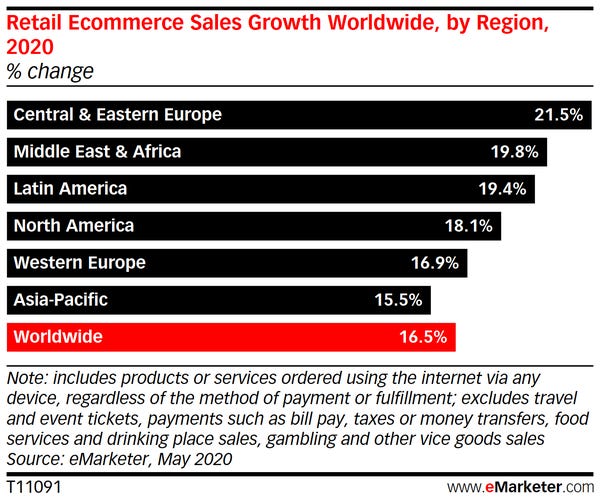As the coronavirus pandemic has lead healthcare authorities to discourage physical social contact as much as possible, the most popular mode of retail, namely brick-and-mortar retail has plunged to unprecedented depths.
But given the salience of commerce in everyday life, people have increasingly adopted online purchases to fulfill both, their needs and whims. Thus, the current scenario of e-commerce has been of great interest to market analysts all around the globe, especially since many economies have opened up, after the first wave of lockdowns.
A report by eMarketer analyzing the current situation of worldwide e-commerce market has concluded that while e-commerce adoption and penetration has grown, the overall rate of progress has decelerated. eMarketer’s rationale behind this conclusion stands in various nuanced facts pertaining to region-specific e-commerce trends.
2019 vs. 2020: Marginal Difference
In last year’s global e-commerce analysis, estimated y-o-y growth was 20.7%, increasing from $2.9 trillion in 2018 to $3.5 trillion in 2019. However, the year growth rate of worldwide eCommerce market continued to decline, starting in 2017. Keeping this dip in mind, the forecast for 2020 in June 2019 stood at $4.2 trillion, with a growth rate of 19%. Additionally, the global e-commerce ecosystem was predicted to grow to become a $5 trillion industry by 2021.
Come 2020, the world was jolted by an unforeseen obstacle. It goes without saying that previous estimates don’t stand true anymore. According to new calculations, the global eCommerce market is estimated to clock 16.5% YoY growth in 2020. The new estimation of global e-commerce is $3.9 trillion, representing a vast difference from the earlier projection of $4.2 billion. However, growth, as is evident, has happened.
The report mentions the role of region-specific data in bringing down/bringing up estimates and figures. While the Asia-Pacific region was the largest driver of growth in 2019, with 25% regional growth, largely owing to China, the region will experience the slowest growth rate this year at 15.5%. However, as in 2019, APAC will continue to enjoy for the largest share of the pie by accounting 62.6% of the eCommerce market, worldwide, in 2020.

North America, the second-biggest shareholder, with 19.1% hold of the market, is in the bottom three in terms of growth rate. This was the same last year.
The Central and Eastern Europe regions have seen the most amount of growth in 2020. In terms of market share, however, Western Europe has the upper hand, with a 12.7% foothold, making it the last region in the top 3 after China and North America, even after housing a few of the first countries to experience lockdowns and spikes in cases after China.
Worldwide E-commerce Sales: By Country
While China’s retail industry, especially brick-and-mortar retail, has shrunk, the country has managed to surpass the US as the largest retail industry in the world. Additionally, Chinese e-retail conglomerates like Alibaba have experienced growth, albeit lesser than that estimated in 2019. One report suggests that Alibaba’s stocks are one of the best to invest in at the moment.
In the US, online retail is expected to increase by 18% to $709.7 billion, but brick-and-mortar retail will decline by 14%. E-sale of food, beverage, healthcare, personal care, and beauty products will increase monumentally, with the forecasts being adjusted to higher figures. However, many US-owned businesses will face losses in international markets.
Canada’s overall retail will shrink by 6.2%, but e-commerce will grow by 20.7%, making up for 8% of overall sales. Canada has seen a breakthrough in terms of online shopping, as data suggests the country wasn’t big on the practice for certain product categories like groceries in the past. Now, online grocery shopping is the largest e-commerce product category.
An idiosyncratic surge in online mobile-phone sales has been seen in Germany.
In Latin America, the prospects seem dire, with the best guess suggesting that each country in the region will have a different road to recovery. Sales are expected to recover to pre-pandemic levels by mid-2022. E-commerce sales will grow by 19.4% with 10.8 million users ordering online for the very first time.
In the APAC, social commerce might become the norm. Currently in the lead in terms of overall and electronic retail, the middle class is expected to drive growth. However, the economic disparity among APAC nations will produce very different country-specific results.
It’s quite evident that despite missing target, estimated earlier, the global eCommerce market continues to thrive in 2020. All we need to see how soon the market recover and if it could touch $5 trillion in 2021 – as estimated last year.

